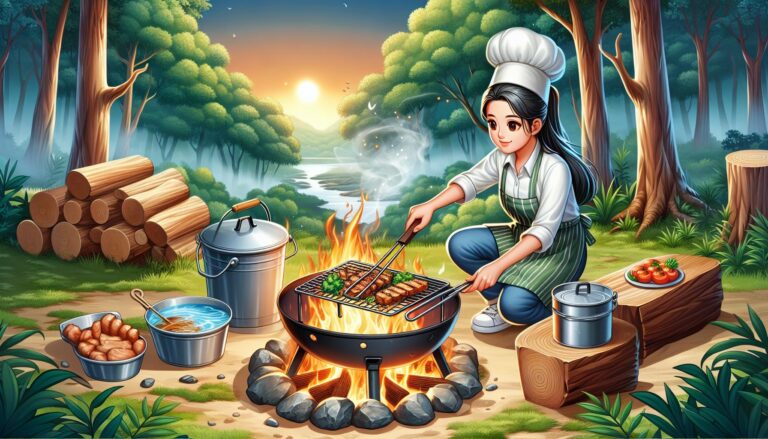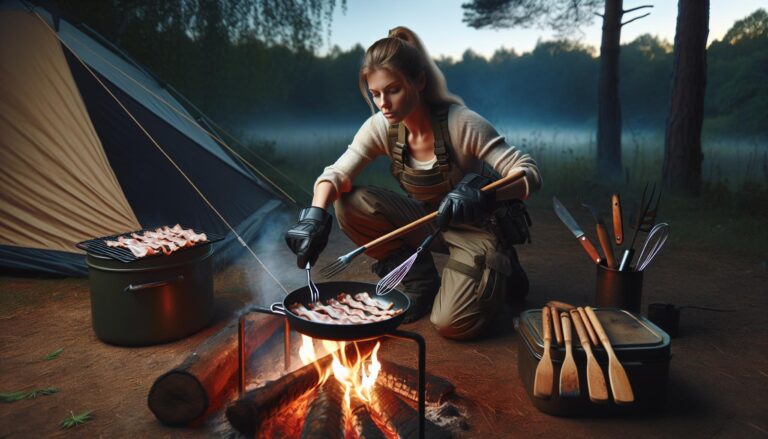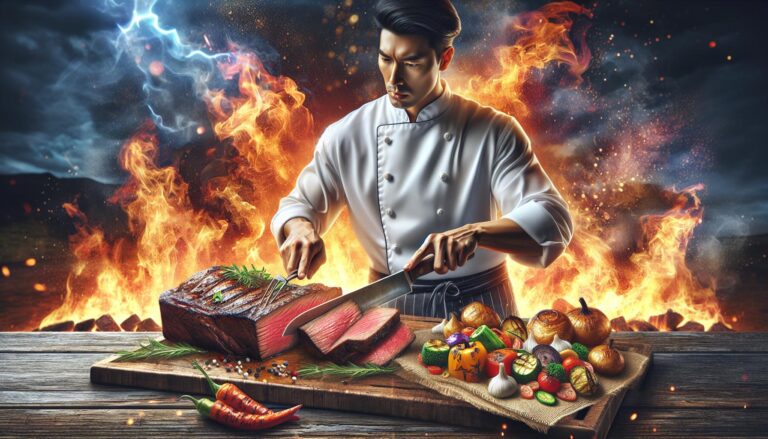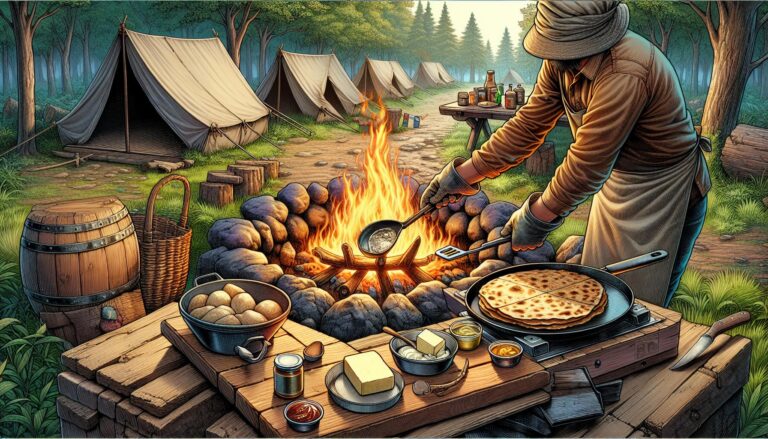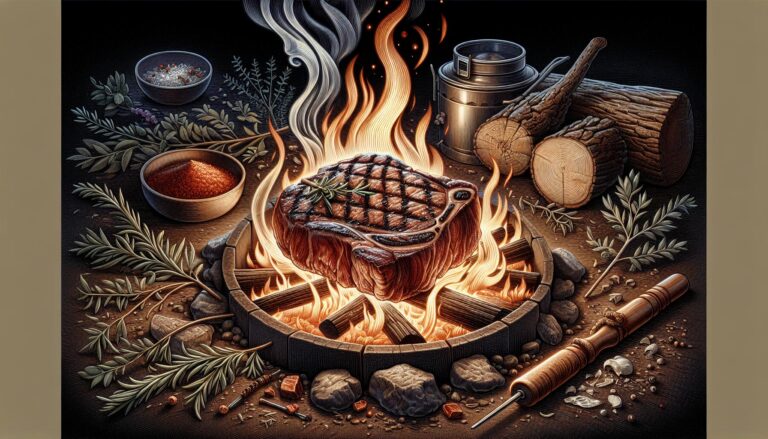Campfire Trout Cooking: Season & Method Guide
Cooking trout on a campfire is a quintessential outdoor experience that combines the thrill of the catch with the joy of cooking. Imagine sitting by a crackling fire, the fresh air mingling with the scent of sizzling fish—it’s an adventure for your senses.
You’ll find that with the right techniques, you can turn your fresh catch into a mouthwatering meal. Whether you’re a seasoned angler or a camping newbie, cooking trout over an open flame can be simple and satisfying.
TLDR: Get ready to learn how to cook trout on a campfire like a pro, transforming your fresh catch into a delicious, smoky-flavored feast with ease and confidence.
Preparing the Campfire
Before you can cook your trout to perfection, you’ll need to set up a proper campfire. This is a fundamental step that’ll make or break your cooking experience. Start by selecting dry wood—hardwoods like oak or maple provide a steady, hot fire that’s ideal for cooking.
Find a Safe Spot: Ensure you’re at a safe distance from trees, bushes, and other flammable objects. Create a fire ring using rocks to contain your fire and prevent it from spreading. Make sure it’s legal to build a fire in your chosen location, and always follow local regulations.
Gather Your Materials: You’ll need three types of materials—tinder, kindling, and firewood.
- Tinder: small, easily flammable items like dry leaves, pine needles, or paper.
- Kindling: small sticks and twigs that’ll catch fire easily but burn longer than tinder.
- Firewood: the backbone of your campfire, which keeps it burning for hours.
Build Your Fire: Start with a small pile of tinder in the center of your fire ring. Add kindling in a teepee shape around your tinder. Light the tinder with a match or lighter, and gently blow to feed the flame. As the kindling catches fire, gradually add larger pieces of firewood to build up your fire to the desired size.
Adjust for Cooking: Aim for a fire that’s strong enough to cook over but not so powerful that it’s unsafe or could burn your food. When it comes to cooking trout over a campfire, embers cook more evenly than open flames. Allow your wood to burn down to a bed of hot embers that offer a steady heat source. Maintain your fire by adding more wood as needed, ensuring you have enough hot embers at all times.
With your campfire ready and at the right temperatures, the stage is now set for cooking your trout to perfection. Remember, patience is key when preparing your campfire. Rushing this process may lead to unevenly cooked fish, so take your time and get it right.
Cleaning and Prepping the Trout

Before you can revel in the rich, smoky flavor of trout cooked over a campfire, it’s vital to clean and prep your catch properly. Safety and hygiene should be your top priorities during this process to prevent any unwanted illness.
Start by washing your hands thoroughly with soap and water. If you’re at a remote campsite, you can use hand sanitizer as a substitute. Next, lay the trout on a clean, flat surface. A cutting board works best, but in a pinch, a washed rock or log can do the job.
Descale the trout by using a knife. Hold the trout by the tail and gently scrape from the tail to the head, removing all the scales. They should flake off easily, but it’s important to be meticulous during this step—leftover scales can affect the texture and taste. After descaling, rinse the trout under cold water.
It’s time to gut the trout. Make an incision from the anus, just below the gills, and pull out the guts carefully. Be sure to remove the bloodline, running along the spine, to eliminate any bitterness. Once you’ve done this, give the trout another rinse.
To add flavor and ensure an even cook, make shallow slits on both sides of the trout. This allows the heat to distribute evenly and the seasoning to penetrate the flesh.
Flavor is key for a memorable meal. Consider stuffing the trout’s cavity with ingredients like:
- Lemon slices
- Fresh herbs (dill, parsley, thyme)
- Garlic
- Onion
These elements introduce a subtle complexity to the trout’s natural taste and will infuse the fish with aromatic flavors as it cooks over the embers. Remember, whatever you use to season, moderation is crucial—don’t overpower the delicate trout flavor.
Once you’ve seasoned, rest the prepped trout aside and get ready to position it over the campfire. You’ll want to monitor the heat closely—the goal is to achieve a perfect balance that will cook the trout through without burning it.
Seasoning the Trout
Once you’ve cleaned and prepped your trout, you’re ready to add some flavor. Seasoning the fish properly can make a big difference in taste, especially when you’re cooking outdoors over an open flame. Let’s explore some classic seasonings that’ll make your trout a hit around the campfire.
Salt and Pepper
Never underestimate the power of the basics. Salt and pepper are essential for bringing out the natural flavors of your trout. Here’s how to do it right:
- Sprinkle sea salt generously inside and outside the trout. This enhances the fish’s flavor and can help form a nice, crisp exterior.
- Add freshly ground black pepper to taste. It should complement the salt without overpowering the fish.
Remember, you can always add more seasoning after tasting the cooked trout, but you can’t take it away once it’s there. So start with a moderate hand and adjust based on your preference.
Lemon and Dill
For a zesty kick and an aromatic addition, lemon and dill are your go-to seasonings. They pair exceptionally well with trout and add a refreshing taste:
- Squeeze fresh lemon juice over the trout or place a few thin lemon slices inside the slits you made earlier.
- Sprinkle dill, either fresh or dried, inside the cavity and on top of the fish. Dill’s light and slightly tangy flavor enhance the natural taste of trout without overwhelming it.
This combination not only tastes great but also gives off a delightful aroma as the trout cooks over the campfire.
Garlic and Butter
If you’re aiming for a rich and sumptuous flavor profile, garlic and butter won’t disappoint. Here’s what to do:
- Mince a few cloves of garlic and mix them with softened butter. This creates a flavorful paste that can be spread over and inside the trout.
- Insert garlic butter into the slits and inside the cavity, ensuring the fish is well-coated. The butter will help keep the trout moist as it cooks, while the garlic adds depth to the flavor.
As the trout cooks, the garlic and butter will meld together, creating a deliciously indulgent dish. Remember to watch the heat closely as butter can burn if the temperature is too high.
Wrapping and Cooking the Trout
Cooking trout over a campfire is an experience that’s both rustic and rewarding. After you’ve seasoned your trout, the next step is to prepare it for the heat. There are several methods to consider, each yielding a different flavor and texture.
Aluminum Foil Method
The aluminum foil method is a campfire classic that steams the fish in its own juices. Here’s how you can get the most out of this technique:
- Lay a large sheet of aluminum foil flat and coat the shiny side with a thin layer of oil to avoid sticking.
- Place your seasoned trout on the foil and add slices of lemon and herbs inside the cavity for extra flavor.
- Wrap the trout tightly in the foil, ensuring it’s sealed well to keep the moisture in.
- Place directly on the campfire coals or on a grill grate for about 7-10 minutes per side, depending on the size of the fish.
Keep in mind that the foil conducts heat rapidly, so check for doneness by carefully unwrapping the foil to see if the flesh flakes easily with a fork.
Cast Iron Skillet Method
For those preferring a crispy skin, cooking trout in a cast iron skillet over a campfire can’t be beaten. Here’s what to do:
- Heat your skillet over the fire until it’s hot.
- Add a small amount of high smoke point oil such as canola or grapeseed.
- Once the oil is shimmering, lay the trout skin-side down.
- Cook for about 4-5 minutes on each side.
This method allows your trout to develop a deliciously crispy exterior while maintaining a tender interior. Keep an eye on the heat as cast iron retains it well and adjust the skillet’s position as needed.
Grilling Method
Grilling gives the trout a smoky flavor that’s hard to replicate with any other cooking method. This is how you can master grilling trout over a campfire:
- Use a well-seasoned grill grate placed over the fire.
- Oil both the grill and the trout to prevent sticking.
- Place the trout on the grill and cook for 4-6 minutes per side, depending on thickness.
Maintain a medium heat, and if you have a grill cover, use it to ensure an even cook. Flipping should be done carefully to prevent the trout from falling apart.
By following these methods, you’ll be able to cook trout perfectly with that satisfying, fresh-off-the-campfire taste that elevates your outdoor dining experience. Whether you seek the juiciness from the foil method, the crispness from the skillet or the unique smokiness from grilling, there’s a method to suit your preference. Remember, it’s about enjoying the process and the flavors nature provides.
Checking for Doneness
When you’re cooking trout by a campfire, knowing when your fish is perfectly done is crucial. You’re aiming for a trout that’s flaky and moist inside with a golden-brown exterior. Here’s how you can check:
- Visual Cues: Look for signs like fish flesh that’s opaque and not glossy anymore. The skin should be crispy to the point of separating easily from the meat.
- Firmness: Gently press the flesh with a fork. It should be firm, and flakes should start to separate. If it’s still mushy, it needs more time.
- Internal Temperature: For precision, use a meat thermometer. The ideal internal temperature of cooked trout is 145°F. Just insert the thermometer at the thickest part of the fish.
Here’s a handy reference table for internal cooking temperatures:
| Fish Type | Internal Temperature |
|---|---|
| Trout | 145°F |
Even if you don’t have a thermometer, these visual and textural cues should guide you to the point where the trout is cooked perfectly.
Pay attention to the heat source as well. Consistent medium heat is ideal because too high of a flame can char the outside and leave the inside undercooked, while too low takes much longer and can dry out the fish.
Remember to let the fish rest for a few minutes off the heat. This resting period allows the juices to redistribute, ensuring each bite is as delicious as the last. It’s also a safety measure to avoid any potential burns from steam or hot oil as you check for doneness.
As you become more experienced with campfire cooking, you’ll start to develop an intuitive sense of when your trout is just right – a skill that’s as satisfying as it is useful. Happy cooking, and relish the mouthwatering aromas that tell you your campfire trout is almost ready to savour.
Serving and Enjoying
Once you’ve mastered the art of checking for doneness and let your trout rest, you’re ready to move on to serving. Whether you’ve cooked it in foil, a skillet, or directly on the grill, presenting your campfire trout can be as rustic or elegant as you like.
Start by transferring the trout to a clean plate or a wooden cutting board for that outdoorsy vibe. If you’ve included herbs and slices of lemon inside the fish during cooking, they’ll make for a beautiful garnish. Remember, the skin will likely have taken on a golden hue and crisped up, adding to the visual appeal.
Eating fish cooked over a campfire is a hands-on experience, so don’t shy away from eating with your fingers if it feels right. However, you may want to provide forks and knives for those who prefer to keep it tidy. Accompany your trout with some simple, easy-to-prepare sides like:
- Grilled vegetables
- A fresh salad
- Crusty bread
These sides don’t just complement the trout flavor-wise, they’re also a breeze to prepare outdoors.
Pairing your meal with the right beverage heightens the experience. A crisp white wine or a chilled beer can match the smoky flavors beautifully, but nothing beats the purity of fresh spring water to let the trout’s natural taste shine.
As you enjoy your campfire trout, take a moment to savor the smoky flavors and the satisfaction of cooking a meal in the great outdoors. Reflect on the methods you’ve used, the seasoning choices you’ve made, and think about variations you might try next time. With every bite, you’re not just nourishing your body; you’re creating memories that last long after the campfire has died down.
Conclusion
Mastering the art of campfire trout cooking is about embracing the great outdoors and the simple pleasures of a well-cooked meal. Whether you choose the convenience of aluminum foil, the traditional touch of a cast iron skillet, or the open-flame allure of grilling, you’re now equipped to turn a fresh catch into a mouthwatering feast. Remember to check your trout for doneness and let it rest before digging in. As you pair your perfectly seasoned and cooked trout with a complementary side and beverage, you’re not just feeding your body but also enriching your soul with the satisfaction of self-sufficiency and the joy of a shared experience. So go ahead, relish every bite and make every campfire cooking adventure one for the books.
Frequently Asked Questions
What seasonings work best for trout cooked over a campfire?
Salt and pepper, lemon and dill, and garlic and butter are classic seasonings that enhance the flavor of trout. It’s important to season to taste and consider personal preferences.
How do you properly season trout for campfire cooking?
To season trout, sprinkle your chosen spices evenly inside and outside the fish. For flavor, insert slices of lemon and sprigs of dill inside the cavity, or slather melted garlic butter over the fish.
What are the methods for cooking trout over a campfire?
The three main methods for campfire trout cooking are the aluminum foil method, using a cast iron skillet, and grilling directly over the fire. Each method requires different steps and cooking times.
How can you tell when campfire-cooked trout is done?
Trout is done when it appears opaque and flakes easily with a fork. It should reach an internal temperature of 145°F and feel firm to the touch. Visual cues and texture are good indicators of doneness.
What are some tips for serving campfire trout?
For a pleasing presentation, serve the trout with lemon slices and fresh herbs. Pair it with simple side dishes such as roasted vegetables or a fresh salad, and select a beverage that complements the flavors of the fish.

